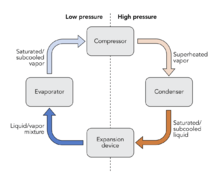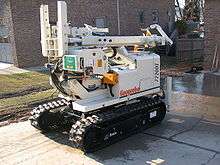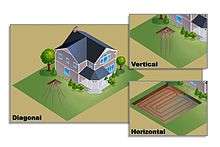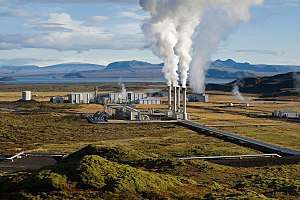Direct exchange geothermal heat pump
A direct exchange (DX) geothermal heat pump is a type of geothermal heat pump (or ground source heat pump) in which refrigerant circulates through copper tubing placed in the ground. It is a closed-loop, refrigerant-based geothermal system.
Direct exchange geothermal heat pumps function similarly to air source heat pumps, according to the principles of vapor compression refrigeration, except they take advantage of the relatively constant ground temperatures, which are less variable than outdoor air temperatures. Ground temperature is cooler than the outdoor air temperature in summer – making for a better heat sink – and warmer in the winter – making for a better heat source. Direct exchange geothermal heat pumps are therefore more efficient than air source heat pumps.[1] They are also quieter, more durable and require less maintenance since they don’t have any outdoor fan or outdoor coil. Furthermore, the uniformity of the underground temperature compared to the outdoor air translates into less stress on the systems.
In direct exchange systems, the refrigerant exchanges heat directly with the soil through the copper tubing. The designation “direct exchange" therefore refers to the heat transfer between the earth and the ground loop without the use of any intermediary. By contrast, water-based geothermal systems rely on two loops on the ground side: a primary refrigerant loop, contained in the appliance cabinet where it exchanges heat with a secondary ground loop that is buried underground and is made of high-density polyethylene containing a mixture of water and anti-freeze (propylene glycol, denatured alcohol or methanol).[2]
Direct exchange systems eliminate the plastic water pipe and water circulating pump found in water-source geothermal systems. This simplicity allows the system to reach high efficiencies while using a shorter and smaller set of buried tubing, reducing footprint and installation cost.[3]
Like all ground source heat pumps, direct exchange systems indirectly harvest solar energy, by absorbing the solar heat stored at the Earth's surface. The US Environmental Protection Agency (EPA) has called ground source heat pumps the most energy-efficient, environmentally clean and cost-effective space conditioning systems available.[4] Geothermal heat pumps offer significant emission reductions potential.
Other Appellations
The technology has many different others names and designations:
- Direct exchange geothermal heat pump
- DX
- Direct Geoexchange heat pumps - currently used by the Air-Conditioning, Heating, and Refrigeration Institute (AHRI) and is abbreviated DGX
- Direct-expansion ground source heat pumps - currently used by The American Society of Heating, Refrigerating, and Air-Conditioning Engineers (ASHRAE)
- Direct geothermal heat pumps
- Refrigerant-based geothermal systems
History

The first geothermal heat pump was a DX system built in the late 1940s by Robert C. Webber.[5] It used Freon gas and buried copper tubing, for increased efficiency.
Later geothermal heat pumps designs started incorporating an additional plastic pipe loop to circulate water in deep wells in an effort to gather sufficient heat for large industrial applications, such as cement plants. Thus water-source technology advanced due to industrial interest while DX, more suited for residential and light commercial projects such as small businesses and private homes, lagged behind.
Gradually developing since the 1980s, DX technology is now experiencing a surge in popularity due in part to its simplicity, efficiency and compact footprint.[6] There is also increasing awareness of environmental and energy issues among urban and suburban residents with limited space in which to install a system.
While the technology was expanding in the 80s and 90s, several of the early manufacturers faced issues with the refrigerant and oil management system. Oil return was especially a challenge with old system using R22 refrigerant and mineral oils, after the ban of CFC refrigerants. This is because R22 and mineral oil separate into two phases in the operating range which can cause return issues in improperly designed systems.[7] Nowadays geothermal systems use polyolester oil (POE) and R-410A refrigerant. POE oil and R-410A mix very well together, which translates into superior oil return characteristics.
Operation Principles

Direct exchange heat pumps are closed-loop geothermal systems which rely on small copper pipes (¼” to 1-1/8”) to exchange heat with the earth. The copper pipes are placed in the ground and form a ground loop – sometimes also referred to as earth loop or refrigerant loop - where the circulating refrigerant undergoes phase transition by exchanging heat with the ground: in heating mode it absorbs heat and changes from liquid to gas (evaporation), while in cooling mode it gives heat off and changes from gas to liquid (condensation).
A direct exchange geothermal heat pump is a type of central heating and cooling system that functions similarly to a standard heat pump, according to the vapor-compression cycle.
In the heating mode the ground serves as the evaporator. Liquid refrigerant coming - through the liquid line- from the heat pump’s indoor coil (serving as the condenser) is expanded and enters the smaller diameter tube of the ground loop. Heat is then transferred from the warmer ground to the ground loop. This leads to the refrigerant boiling to a vapor (evaporation) as it progresses through the loop. The refrigerant vapor then exits the ground loop and is returned -through the vapor line- to the compressor unit. Once in the compressor, the refrigerant is compressed to a higher pressure and temperature. The hot, superheated refrigerant vapor is now delivered to the indoor coil (condenser) where it gives off heat to the cooler building’s final delivery fluid with the assistance of the indoor circulator. As the refrigerant vapor gives off heat, it gradually condenses back to the liquid state.
In the cooling mode the ground serves as a condenser. Superheated vapor refrigerant from the heat pump’s compressor is pumped -through the vapor line- into the larger diameter tube of the ground loop. Heat is then transferred from the ground loop to the cooler ground. This leads to the refrigerant condensing to a full liquid as it progresses through the loop, as shown in Figure 12. The refrigerant liquid then exits the ground loop and is returned -through the liquid line- to the indoor coil to be re-expanded to a lower pressure and temperature. This will enable it to absorb heat from the space to condition with the assistance of the indoor circulator. It will also enable it to dehumidify thanks to the indoor coil (evaporator) temperature being lower than the room temperature dew point. As the refrigerant absorbs heat while passing through the indoor coil (evaporator), the refrigerant evaporates and exits as a saturated vapor towards the heat pump’s compressor.
Applications

Direct exchange systems are rather simple refrigerant-based systems and operate without requiring anti-freezing agents, system flushing, circulating pump, water well drilling or plumbing.
Depending on the models, they can provide space heating, space cooling, domestic water heating as well as radiant floor hydronic heating and chilled water cooling.
Direct exchange geothermal systems are the least invasive geothermal systems and feature small earth loop size. Because of that, they can be installed in relatively small areas and in relatively shallow soil - typical loop depth does not exceed 100 linear feet.
Since the length of the ground loop system is minimized, DX systems require smaller drill rigs - in comparison with water well rigs - which can get into smaller spaces and yards. This provides a greater flexibility of installation and makes it an available option in more areas and for more properties.
The compactness of the earth loop systems, which require less drilling and smaller borehole, makes up for a simpler system that is cheaper and quicker to install.

The relative simplicity of refrigerant-based systems – relying on a one-step heat exchange process – translates not only into a simpler and less expensive installation but also into less maintenance as well: unlike water-based systems, they do not require maintenance to top up water and glycol levels.
Use of Copper
Direct exchange systems use copper because it is an excellent ground heat exchanger material and easy to manufacture. Copper tubing is strong and ductile; resistant to corrosion; has a very high thermal conductivity; and is available in many different diameters and in long coil lengths. Copper connections can be brazed, the tubing may be bent, and copper tubing is economically available.
In addition, copper has a long history of use in air conditioning and refrigeration, and is the material of choice for potable water for water lines buried underground and in buildings.
Copper has been used since antiquity in architectural constructions because it is a noble metal – one of a few that can be found naturally in the ground. This makes it a durable, weatherproof and corrosion-resistant material with an indefinite lifetime in most soils.
Although copper is extracted from the ground itself and is a noble metal - and is therefore almost completely impervious to corrosion from soils found worldwide - it might still undergo some corrosion in abnormally aggressive soils.[8] It generally requires an oxidizing environment to start corrosion, and most soils are reducing, thus they contribute electrons to the copper and protect it against corrosion. In those areas where corrosive conditions may exist, copper will then naturally form a protective film on its surface which remains intact under most soil conditions.
In anticipation of particularly corrosive soils, DX systems come with a Cathodic Protection system. The principle is to protect the metal surface from corrosion by making it the cathode of an electrochemical cell. In that process, the metal –copper – is connected to a sacrificial metal which will corrode in its place. Corrosion of metals is an electrochemical process of deterioration that results from a loss of electrons as they react with water and/or oxygen. As the current flows from the Earth Loop Protection system, the metal surface to be protected is given in a uniform negative electrical potential that precludes corrosion of the ground loops, even in hostile environments.
Ground loop configuration

The ground loop system may be installed in several different configurations. The three most common configurations are:
- Vertical
- Diagonal
- Horizontal
Diagonal and Vertical configurations typically require drilling and grouting to be installed in drilled bore holes. Grout reseals the earth below the surface so that natural ground water aquifers are not interrupted. All diagonal and vertical systems must be grouted from the bottom up to the top.
Diagonal systems usually have a very small footprint.
Horizontal configurations usually only require trenching to be installed in excavated trenches or a pit. Horizontal systems do not usually require grout, except in the case of directional boring.
System sizing
DX systems are currently manufactured in sizes from 1.5 tons (5.25 kWth) to 15 tons (52 kWth). Larger projects can be accomplished through installation of multiple units.
See also
References
- ↑ "ASHP vs. GSHP | GeoConnections Inc". geoconnectionsinc.com. Retrieved 2016-11-17.
- ↑ "The Types of Antifreeze Used in Geothermal Heat Pump Earth Loop Fluid". Retrieved 2016-11-17.
- ↑ "Applications: Tube, Pipe & Fittings: Direct-Exchange Geothermal Heating/Cooling Technology". www.copper.org. Retrieved 2016-11-17.
- ↑ Environmental Protection Agency (1993). "Space Conditioning: The Next Frontier - Report 430-R-93-004". EPA.
- ↑ "About Us | What is IGSHPA?". www.igshpa.okstate.edu. Retrieved 2016-11-17.
- ↑ "Geothermal Industry to See Rapid Growth". Earthlinked Technologies. 2016-11-28. Retrieved 2016-11-28.
- ↑ "OIL IN REFRIGERATION SYSTEMS" (PDF). RSES.
- ↑ "Corrosion Protection & Resistance: Conditions Contributing to Underground Copper Corrosion". www.copper.org. Retrieved 2016-11-17.
External links
- Geothermal Heat Pumps (US Department of Energy)
- US Dept. of Energy
- Geothermal Exchange Organization (GEO)
- Canadian Geoexchange Coalition
- International Ground Source Heat Pump Association (IGSHPA)
- Ground Source Heat Pump Association - UK
- Air-Conditioning, Heating, and Refrigeration Institute (AHRI)
- The American Society of Heating, Refrigerating, and Air-Conditioning Engineers (ASHRAE)
- Copper Development Association Inc.
